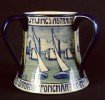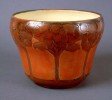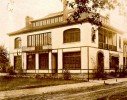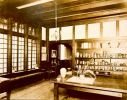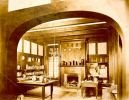 | Find Louisiana State Museum on Facebook |
 | Find Louisiana State Museum on Twitter |
| 2016 Sunset Report |
| OLG & DCRT Strategic Plan 2020-21 through 2024-25 |

- Quality - Louisiana State Library
85% of the users of the State Library indicated that the State Library's services and resources was a good value for the State.Source: The Impact of the Louisiana Department of Culture, Recreation and Tourism on Louisiana's Economy and Quality of Life for Louisiana's Citizens - June 2006
- Louisiana's deep water ports
Did you know that Louisiana's five deep water ports handle more than 457 million tons of U.S. waterborne commerce a year? - Quality - Louisiana State Library
85% of the users of the State Library indicated that the State Library's services and resources was a good value for the State.Source: The Impact of the Louisiana Department of Culture, Recreation and Tourism on Louisiana's Economy and Quality of Life for Louisiana's Citizens - June 2006
- Atchafalaya Heritage Area
The Atchafalaya Heritage Area has been designated by Congress as a National Heritage Area.
- Impact - DCRT Returns Investment Dollars to Louisiana
For every state tax dollar spent by the Department of Culture, Recreation and Tourism, $5.86 is returned to the State Treasury and citizens of Louisiana.Source: The Impact of the Louisiana Department of Culture, Recreation and Tourism on Louisiana's Economy and Quality of Life for Louisiana's Citizens - June 2006
- Impact - Louisiana Office of Tourism Tops Returns on Investment
$13.90 is the return on investment for every dollar spent by the Office of Tourism. Over 175,000 people were directly employed by the Louisiana travel and tourism industry in 2004. In terms of production, $5.9 billion (3.8%) of Louisiana's Gross State Product was directly attributable to expenditures by visitors to LouisianaSource: The Impact of the Louisiana Department of Culture, Recreation and Tourism on Louisiana's Economy and Quality of Life for Louisiana's Citizens - June 2006
- Impact - Supporting the Louisiana Arts
Every dollar in state support for the Arts leverages $7 in earned and contributed revenue. Louisiana's cultural enterprises provide nearly 144,000 jobs for Louisiana citizens, accounting for 7.6% of total employment. Arts has a total economic impact of $934 million in Louisiana.Source: The Impact of the Louisiana Department of Culture, Recreation and Tourism on Louisiana's Economy and Quality of Life for Louisiana's Citizens - June 2006
- Impact - Visitors Generate State Revenue
In terms of tax revenues, visitor spending accounted for $677 million of 2004 Louisiana revenues, or 8.3% of the total 2004 State Budget.Source: The Impact of the Louisiana Department of Culture, Recreation and Tourism on Louisiana's Economy and Quality of Life for Louisiana's Citizens - June 2006
- Quality - Louisiana State Museums
95% of State Museum's visitors strongly agreed or agreed that the State Museum was an educational experience and has expanded their awareness of Louisiana's cultural history.Source: The Impact of the Louisiana Department of Culture, Recreation and Tourism on Louisiana's Economy and Quality of Life for Louisiana's Citizens - June 2006
- Quality - Historic Preservation and the Arts
78-80% of Louisiana residents believe that historic preservation and arts are important and should be high priorities.Source: The Impact of the Louisiana Department of Culture, Recreation and Tourism on Louisiana's Economy and Quality of Life for Louisiana's Citizens - June 2006
- Impact - Louisiana Serve Program
The Louisiana Serve Program in the Office of Lieutenant Governor returns 2.8 million in non-state revenue to Louisiana. - Impact - Louisiana State Museum
The Office of State Museum returns $6.99 for every tax dollar spent.Source: The Impact of the Louisiana Department of Culture, Recreation and Tourism on Louisiana's Economy and Quality of Life for Louisiana's Citizens - June 2006
- Impact - Louisiana State Parks
Visitor spending at Louisiana State Parks returns $3.23 in state taxes for every dollar spend on operating and maintaining all our beautiful parks. Out-of-state visitors to Louisiana State Parks spent almost $12 million in Louisiana and produced an economic impact of over $24 million. Louisiana residents spent another $29.2 million while visiting the parks.Source: The Impact of the Louisiana Department of Culture, Recreation and Tourism on Louisiana's Economy and Quality of Life for Louisiana's Citizens - June 2006
- Impact - Scenic Byways Program
The Scenic Byways program leverages $1.56 for every dollar spent by the program.Source: The Impact of the Louisiana Department of Culture, Recreation and Tourism on Louisiana's Economy and Quality of Life for Louisiana's Citizens - June 2006
- Louisiana State Parks and the National Register
Thirteen Louisiana State Parks sites are on the National Register of Historic Places. They include:
• Audubon State Historic Site
• Centenary State Historic Site
• Fort Pike State Historic Site
• Fort Jesup State Historic Site
• Longfellow-Evangeline State Historic Site
• Mansfield State Historic Site
• Marksville State Historic Site
• Plaquemine Lock State Historic Site
• Port Hudson State Historic Site
• Poverty Point State Historic Site
• Otis House at Fairview-Riverside State Park
• Rosedown Plantation State Historic Site
• Winter Quarters State Historic Site - Louisiana State Parks Visitation
Nearly two million people visited a Louisiana State Park last year. - Louisiana State Parks Grow and Renew
The Louisiana Office of State Parks has spent nearly $80 million in major construction projects since 2004, providing two brand-new parks and a new historic site, adding cabins and campsites to existing parks and building visitor center at one park, the preservation area and three historic sites. - Louisiana State Parks Wireless Internet
The Louisiana Office of State Parks provides free wireless internet access at all 20 recreational parks. Extensive coverage areas include most cabins, RV slips and campsites. - Louisiana State Parks Online Reservations
You can now make online reservations for cabins, campsites, lodges and group camps – at www.ReserveLaStateParks.com - Louisiana State Parks Honors National Parks Service Senior Pass Program
Visitors who hold an America the Beautiful Senior or Access Pass, and whose home State Park system honor the America the Beautiful passes for camping discounts, are entitled to a 50% reduction on camping fees at Louisiana State Parks. Certain restrictions apply, see State Parks' fees & facilities page for more information. - Louisiana State Parks Draw Media Attention
Louisiana State Parks sites have been featured in movie and television releases including "True Detective," CBS’ "Zoo," and "NCIS: New Orleans," "G.I. Joe: Retaliation," "Selfless," "Devil’s Due," and commercials for Popeyes and Toyota. - Capitol Park Welcome Center
The main meeting room in the Capitol Park Welcome Center is named after Margaret Taylor, wife of U.S. President Zachary Taylor. The couple resided in a small house near the present day location of Capitol Park until Taylor was elected to the Presidency.
| Table of Contents | Section 1 | Section 2 | Section 3 | Section 4 | Selected Bibliography |
Middle Newcomb Wares
Art pottery around the country was affected at the turn of the century when new design theories were published in Arthur Wesley Dow’s 1899 Composition. Dow recommended simplification of compositions and elimination of naturalistic modeling or rendering. He used bold outlines to arrange and organize space, and chose palettes with close tonalities.
Between 1900 -1906, some of Newcomb’s most talented and prolific instructors and students attended Dow’s Ipswich, Massachusetts summer sessions: Henrietta Bailey, Marie Levering Benson, Sarah Henderson, Harriet Joor, Roberta Beverly Kennon, Marie deHoa LeBlanc, Amelie and Desiree Roman, and Mary Sheerer.
The Newcomb pottery color scheme was essentially unchanged, but the effect Dow’s ideas had on decoration was pronounced. Designs were outlined in thick black lines of pigment and horizontal bands were added to make spatial divisions on the pots. Several years later, this outlining led to the second phase of pottery decoration at Newcomb, when both motif and banding were deeply carved into the pots in straight even incisions. Pottery production now had a unity of appearance and Newcomb emerged with a cohesive, recognizable line of work. Sheerer favored the outlining, feeling it accentuated the shapes of the vessels on which it was carved.
Meyer continued to experiment with glazes and produced a stunning red lustre around 1903. Few Newcomb pots were actually finished with this glaze, perhaps because of the unpredictable firing technique required. The lustrous surface recalled popular English glazes, notably those used by leading pottery designer, William De Morgan, who worked at Morris’ Merton Abbey.
During this middle phase of Newcomb, Sarah Agnes Estelle, or "Sadie", Irvine joined the art program. Considered by ceramist Paul Cox to be the College’s greatest designer, Irvine was active longer than any other member of the Pottery, serving for fifty-two years as student, decorator, instructor, and finally as the head of the ceramics department from 1942 until her retirement in 1952.
Newcomb Potters
Mary Given Sheerer, hailing from progressive Cincinnati, advocated student-thrown wares from the beginning of her tenure, but other administrators felt the commercial success of the Pottery necessitated hiring professional male potters already adept at their craft. And, in the Victorian South, it was more acceptable for the heavy, messy and sometimes dangerous chores of clay mixing, pot throwing and kiln firing to be done by men. The first two Newcomb potters, Jules Gabry and George Wasmuth, stayed briefly. The third potter was hired in 1896; Joseph Fortune Meyer contributed some 30 years to the success of Newcomb Pottery.
French-born Meyer learned the craft from his father, a potter who sold utilitarian wares in the French Market. A gifted artisan capable of accurately turning any shape the Newcomb women requested, he was affectionately called the "wizard" by the students. Meyer received a silver medal at the St. Louis 1904 Louisiana Purchase Exposition for his experimental glazes. Succeeded by several potters when he retired from Newcomb in 1927, Meyer’s talent and proficiency at the wheel were never matched.
[It should be noted that it was not until about 1930 that students began throwing on the wheel, although hand-built ceramics were created quite early on in the history of the Pottery.]
 Joseph Meyer at the Wheel |  Potting Building Interior Teunisson |
Numerous undecorated vessels document the continued experimentation with glazes throughout the history of pottery production at the College. The majority of these pots bear the stamp of award-winning potter Joseph Meyer. That examples of unsuccessful experiments survived in addition to acceptable results is all the more interesting.
Artistic and Commercial Success
The theory of the commercial program was simple. After completing undergraduate course work, the girls could opt for additional training in a two-year graduate program initiated in 1895-96. The students moved to professional status to sell their pieces deemed acceptable by the jury in a salesroom maintained by the art department. At the beginning of the pottery program, Newcomb College supplied all of the equipment and paid the potter, but the students were responsible for their materials, and received money only when a piece was purchased. The first Newcomb pot was sold in 1896. Pottery sales had doubled by 1901, and a new payment system was devised to remunerate decorators for any work they completed, whether it survived the kiln firing or was sold in the shop.
At this nation’s first Arts and Crafts exhibition in Boston in 1897, Grueby and Dedham Pottery (formerly the Chelsea Keramic Art Works) provided the primary ceramic displays. From 1898 onwards, Newcomb established an ambitious exhibition schedule for its wares and sent pottery examples to Arts and Crafts exhibitions around the country.
Newcomb wares were recognized for their excellence almost from the inception of the Pottery. The list of awards is impressive, totaling eight medals and forty-four blue ribbons including:
- 1900 Paris Exposition - bronze
- 1901 Pan-American Exposition in Buffalo - silver
- 1904 St. Louis Louisiana Purchase Exposition - silver
- 1907 Jamestown Ter-Centennial in Norfolk - gold
- 1915 Panama-Pacific International Exposition in San Francisco - silver
- 1913 National Conservation Exposition in Knoxville - gold
As Newcomb’s reputation grew in the ceramic world as a result of numerous exhibitions, awards, and reviews, so too did the public demand for the pottery. A system of registration marks was initiated in 1901 to help with the increased inventory of pots. Alphabetic and numeric codes indicating the year of manufacture were stamped, incised or painted on the bottoms of pieces, along with the potter’s and decorator’s ciphers, and often a clay body or glaze symbol.
Orders for Newcomb pottery were placed from around the country, and by 1907 sales agents were established in San Francisco, Los Angeles, Boston, Philadelphia and St. Louis. The same year, Chicago’s Marshall Field, already selling Morris-designed fabrics and furniture, marketed Newcomb as well. Gustav Stickley sold the College’s pots alongside his furniture in 1915.
Late Newcomb Wares
Seeing a need for greater technical knowledge of pottery production, Mary Given Sheerer attempted to pursue additional training. The baffling appearance of black specks on some of the wares emphasized the College’s need for chemical expertise. Although Sheerer’s desire to acquire more education was not supported, Professor Woodward hired a professional ceramic chemist in 1910, Paul E. Cox. One of the first students of Charles Fergus Binns at the famous New York State School of Clay-Working and Ceramics (known today as Alfred University), Cox changed the history of Newcomb Pottery.
Influenced by French ceramics shown at the 1893 Chicago World’s Fair, William Grueby developed a number of mat glazes and introduced them into his pottery line around 1898. Grueby Pottery was often associated with the "mission" style furniture of Gustav Stickley, the two quite often displayed together as they were in the 1901 Pan-American Exposition in Buffalo. Stickley also used Grueby tiles in his Craftsman homes. The popularity of Grueby’s glazes, in particular a thick green one, as well as other mat glazes used around the country, prompted Cox to replace Newcomb’s shiny glaze with a translucent mat one. The ceramist also updated and rebuilt much of the pottery’s equipment and kilns.
About 1908, some of the Newcomb decorators began to model their designs in very low-relief, and reduced the severity of their outlining. By the time the new glaze was introduced in 1910, decoration methods had shifted dramatically.
- Floral motifs continued to dominate the designs.
- Students still ground their own dry blue and green underglaze pigments on glass palettes, mixed them with water, and dabbed the colors onto the surface of the bisqued pot with a sponge.
- Linear incisions gave way to delicate, low-relief sculpted ornamentation.
The overall soft, muted and more atmospheric appearance was completely different. Interestingly during this period, Arthur Wesley Dow’s own paintings became fuzzy and atmospheric.
 Vase with Narcissus Sadie Irvine, decorator Joseph Meyer, potter 1913 Gift of Mrs. Martha Hart-Miles |
By the beginning of World War I, the Arts and Crafts movement, both abroad and in the United States, had declined. Grueby Pottery was bankrupt in 1908. Elbert and Alice Hubbard, founders of the Roycrofters community, were lost on the Lusitania in 1915, their Roycroft shops eventually sold in 1938. In 1916, the year used by many art historians as the terminus of the Arts and Crafts era, the Craftsman magazine folded.
Shifts in artistic tastes certainly played a role in the descent of the movement. But the fact that the movement had accomplished many of its goals -- redefining craft design and manufacture, establishing educational and training programs, founding new art museums, and creating employment for female artisans -- also encouraged priorities of the public to change.
Like the movement itself, Newcomb Pottery - the award-winning and most famous example of the Arts and Crafts style in the American South - eventually came to be replaced by other, newer concerns. Three of the most inspirational figures of the Pottery retired within a brief time.
- The beloved potter Joseph Meyer left in 1927
- Department chairman Ellsworth Woodward and instructor Mary Given Sheerer retired in 1931 (Meyer died the same year).
- Ceramic chemists, too, were replaced frequently after the departure of Paul Cox in 1918
- Fred Walrath, Vincent Axford and Harry Rogers each stayed but a few years. (Finally, Kenneth Smith remained from 1929 until his retirement in 1945.)
The more romantic, "Southern" scene decoration led to conservative, less creative products. Although Newcomb still produced one of a kind pots, the repetitive decoration came to be regarded as old fashioned, and the number of professional decorators decreased significantly as did sales.
In the mid twenties and thirties, several new design lines incorporating more current artistic trends were introduced to rejuvenate the pottery. Decorators experimented with abstract and geometric patterns, inspired by Mary Sheerer’s reaction to the 1925 Paris International Exposition of Decorative Arts and the Art Deco style. Obviously distressed by the conservative naturalistic Newcomb designs, Sheerer commented, "does it not seem more honest to glorify the straight line as the Exposition does, than to apathetically fall back on the thought of other times and recline too long and too entirely on the curves of precedent?"
The attempts to update the pottery did little to return Newcomb to its earlier glory. Perhaps the greatest blow was the rejection in 1929 of Newcomb pottery from an exhbition of American ceramics at Michigan’s prestigious Cranbrook Foundation. Newcomb Pottery closed in 1940, replaced by the Newcomb Guild and a line of modern, undecorated utilitarian wares with beautiful glazes. The Guild never gained sufficient public support and it, too, ceased operation in 1944.
Other Newcomb Crafts
Meticulous records, as well as a consistent system of marks made by decorators and potters, document the evolution and production of much of Newcomb’s ceramic creations. Considerably less is known about the other crafts made at the College, also subjected to jury approval and sold in the sales room. School records of these products are scant; fewer of these pieces were made, survived, or signed by the artist. A variety of courses was offered in the art school curriculum, including embroidery, bookbinding, metalwork, printmaking and stained glass. These courses were an important segment of education at the College and exposed the students to a nearly full range of the crafts revived by American and English Arts and Crafts reformers.
Although less publicized than the pottery, the other Newcomb crafts were impressively designed and executed. And, in some ways, the output of the textile, book and jewelry programs exceeded in design, if not numbers, the late products of the pottery. Of course, this may have resulted from a number of factors. Unlike the internationally renowned pottery, far fewer orders were placed for the other crafts. Jewelers and embroiderers were apparently not subjected to pressure to produce great quantities to satisfy sales orders. Instruction in the other Newcomb crafts also began later than the pottery program. By the time embroidery and book courses were launched at Newcomb, successful needlework shops and binderies were already established in the States; the Pottery had considerably fewer successful models. And, the more technical demands of pottery production cannot be ignored: compatibility of clay and glaze recipes; carving, painting and drying of fragile unfired greenware; and unpredictability of kiln firings. That these multi-stage techniques changed repeatedly over the life of the pottery undoubtedly complicated production and frustrated decorators and instructors alike.

